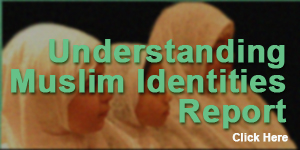
[The following is an excerpt from Understanding Muslim Identities: From Perceived Relative Exclusion to Inclusion by Samina Yasmeen (Centre for Muslim States and Societies , University of Western Australia), written in May 2008 and available as a pdf at http://www.omi.wa.gov.au/.]
Islam in Australia
Islam and Muslims are not new to Australia. The history of Muslim contacts with
Australia predates European settlement. Fishermen from Macasser regularly visited
Australia’s northern shores in December for four months to catch trepang. While self
sufficient and non-intrusive, the regular contacts left their mark on the language and
culture of the indigenous communities of the Arnhem Land and neighbouring areas.
These indigenous communities borrowed words from the Macassans’ vocabulary and
depicted their influence in their paintings. The first regular settlement of Muslims in
Australia, however, started in 1860 with the arrival of 3 camel-drivers from British India.
Over the next fifty years, their number exceeded 2,000. Coming from the North Western
Frontier Province and Baluchistan of the British Indian colony (which now forms part of
Pakistan), and Afghanistan, these people were identified as Afghans, or Ghans. They
provided the most reliable and efficient transport system between different colonies. At
the same time they left a mark on Australian history. As devout Muslims, these Afghan
cameleers built towns and mosques where they could practise their religion and coexist as
tightly knit communities. Since they were not permitted to bring their wives from British
India, these Afghans also married the women from ‘peripheral classes of Australia’
including widows, poor Anglo-Saxon women and Aboriginal women. Their off-spring
were the first known Australian-born Muslims.
By 1921, the total number of Muslims living in Australia, including Afghans and others
especially Malays, was estimated to be less than 3,000. With the arrival of Albanian
Muslims, the number increased slightly after the First World War. Once the Second
World War came to an end, Muslims from Yugoslavia, Cyprus, Poland, Hungary and
Russia also arrived as part of the agreements concluded between the International
Refugee Organisation and Australia. But the number of Muslims in the country remained
small. In the early 1970s, a combination of the changed Australian immigration policy
and political instability in Lebanon brought a new wave of Muslim immigrants to
Australia. Thereafter, the proportion of Muslims in the population increased slowly but
consistently. The events surrounding the Gulf Crisis/Gulf War created another wave of
Muslim immigration into Australia. By 1991 the census showed 146,600 Muslims were
living in Australia. Of these, 51,321 or 35% were born in Australia, whereas the
remaining Muslims traced their origin to 67 different countries, ‘making them one of the
most ethnically diverse religious group in the country’. Thereafter, the immigration of
refugees from Africa, Iraq and Afghanistan increased the total number of Muslims in
Australia. By 2001, their number in Australia had increased to 281,586 (or 1.5% of the
total Australian population). This reflected a 40.2% increase since the previous Census in
1996.
According to the 2006 Census, 340,392 Muslims live in Australia comprising 1.71% of
the total population. This reflects a 69.4% increase since the 1996 Census.9 Of these
37.8% (or 128,903) have been born in Australia with almost 48.7% under 25 years of age.
Unlike the general Australian picture, the Muslim population in Australia consists of
more males (52.2%) than females (47.8%). They are mostly concentrated in New South
Wales and Victoria with 81.6% of the total Muslim population living in these two states.
Sydney and Melbourne are the two major cities accounting for 47% and 30.3% of the
total Muslim population respectively. The number of Muslims in other capital cities has
also increased with Brisbane and Perth registering 41.1% and 27.1% increase since the
2001 Census respectively.
Muslims living in Australia come from ethnically diverse backgrounds. After the largest
cohort of Australian-born Muslims, those from Turkey and Lebanon constitute the two
largest ethnic groups. Other countries contributing the bulk of the Muslim population in
Australia include Afghanistan, Bosnia and Herzegovina, Pakistan, Indonesia, Iraq,
Bangladesh, Iran and Fiji.